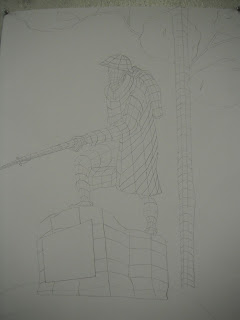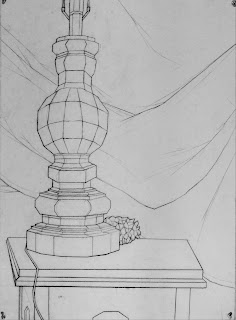We had an informal crit today that went quite well. Some work still needs to happen to finalize these pieces but overall, I'm really pleased.
Great job all.
Thursday, September 27, 2012
Wednesday, September 26, 2012
Portrait Head Homework
Ruler Drawing: portrait head in planes (line only). Work from observation with a sitter. Reduce the head to a series of lanes which clearly definte the volume of the head as well as major features such as eyes, nose, mouth, ears, hair.
Tuesday, September 25, 2012
Planar Analysis In-progress crit
Hey all,
You guys are doing great with planar analysis!
A Reminder:
2 Still-life Drawings (white bond) + 1 Drapery (HW 22''x30'') + 1 Statue (white bond) due Thursday, September 27.
We will have an in-progress critique to check in on how everyone is doing working with planar concepts + materials.
You guys are doing great with planar analysis!
A Reminder:
2 Still-life Drawings (white bond) + 1 Drapery (HW 22''x30'') + 1 Statue (white bond) due Thursday, September 27.
We will have an in-progress critique to check in on how everyone is doing working with planar concepts + materials.
Thursday, September 20, 2012
Drapery Homework
Set up your still life at home. Use a solid colored sheet or blanket and drape over a chair or table until you get a desired view. Draw the full space (line only).
Materials: charcoal pencil, metal yardstick, eraser ad good paper (22''x30'')
Materials: charcoal pencil, metal yardstick, eraser ad good paper (22''x30'')
Sunday, September 16, 2012
Examples of 2-point Interiors
Use these examples as a guideline for details / expectations for final interior drawing. HINT: Make sure your furniture is placed so that it fits into your 2 point perspective system.
Thursday, September 13, 2012
Documenting Your Work
Things to think about.
Photography vs. Scanning
Scanning is going to give you the best digital image for a 2D work. All the work in this class is 2D. However, we run into a problem when we consider that we must scan a piece of art that is 24''x18''. What should you do? In this case, I would you digital photography to document your work.
1. Find a clean, white wall to pin up work. If possible, use double-sided tape or mounting sticky paper to adhere paper to wall. If you do this, you avoid having to crop out pins later in the process.
2. Make sure your light is bright and even. If it is uneven, you will have light and dark spots. That is no good. You also need to make sure you have a lot of light in general. Typically a flash will wash out your work and also create a bright spot right in the middle of your image.
3. Make sure your settings on your camera are set for 300dpi (high resolution), RGB color mode (Red, Green, Blue color mode - this color mode is designed for screen viewing.) You can also set your image type on your cameras - If you can, set you image to .tiff as it will give you the best quality. Keep in mind, these files are large.
4. Shoot your image as cropped in as possible and as straight and clear as possible. If you do this, you will avoid having to edit/crop image in photo imaging software.
Photoshop / Image Software
1. You should not be using photoshop to drastically change your work. This is not the point of the software, at least for this class. You should, however use the capability of the computer to get your image looking as close to humanly possible to the real piece of art.
2. Cropping tool: Use the cropping tool to cut off any excess part of the image.
3. Transition / Rotate tool: Use the rotate tool to orient image in the way that it is supposed to be presented (i.e., portrait, landscape)
6. Other tools you might use to adjust image - brightness/contrast tool. This will adjust some lighting for you.
Saving digital files.
1. For all work, you must save your files 2 ways. This is true for the real world as well.
2. Firstly, save your final digital image as FirstnameLastname_hires_ArtworkName.tiff
3. You should do this for every work.
4. Secondly, you will save a lores image to include on your blog. This should not be a .tiff file. Save this image as .jpg file.
How to create a lores image
1. Image > Image Size > Change setting from 300dpi to 72 dpi. This is the standard for all online images.
2. Files > Save as > change extension from .tiff to .jpg
3. You should now have 2 images for one piece of artwork saved.
Assignment:
1. Periodically, you will be asked to document completed work (that has been graded and handed back to you). You will digitally document work and post it to your blog. This will be announced the same way blog assignments are announced.
2. At the end of the semester, you will turn in a disc that has all your work, labeled as mentioned above, and you will save it on a disc. You should save both the hires / If you do this correctly, you should see a large list of work that looks something like this...
CatNormoyle_hires_OnePointInterior.tiff
CatNormoyle_hires_OnePointStillLife1.tiff
CatNormoyle_hires_OnePointStillLife2.tiff
CatNormoyle_hires_TwoPointExterior.tiff
3. You should label your CD/DVD with your Name, Drawing 1, Fall 2012, MCA
Tuesday, September 11, 2012
Subscribe to:
Comments (Atom)























































